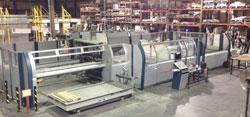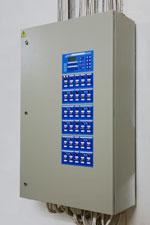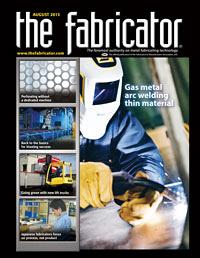Editor-in-Chief
- FMA
- The Fabricator
- FABTECH
- Canadian Metalworking
Categories
- Additive Manufacturing
- Aluminum Welding
- Arc Welding
- Assembly and Joining
- Automation and Robotics
- Bending and Forming
- Consumables
- Cutting and Weld Prep
- Electric Vehicles
- En Español
- Finishing
- Hydroforming
- Laser Cutting
- Laser Welding
- Machining
- Manufacturing Software
- Materials Handling
- Metals/Materials
- Oxyfuel Cutting
- Plasma Cutting
- Power Tools
- Punching and Other Holemaking
- Roll Forming
- Safety
- Sawing
- Shearing
- Shop Management
- Testing and Measuring
- Tube and Pipe Fabrication
- Tube and Pipe Production
- Waterjet Cutting
Industry Directory
Webcasts
Podcasts
FAB 40
Advertise
Subscribe
Account Login
Search
Fabricator finds versatility in panel bender
Innovated Machine keeps up with bending jobs that press brakes struggle with
- By Dan Davis
- August 9, 2013
- Article
- Bending and Forming

Figure 1: Before it made the jump into panel bending, the management team of Innovated Machine & Tool Co. Inc. visited an Indianapolis fabricator to see how they were using the automated bending equipment.
Dwight Bryant could have had a P4. It wasn’t a vegetable drink that he missed out on in 2001. The owner of Innovated Machine & Tool Co. Inc., Newport News, Va., was in the middle of a large expansion. The company, which he had worked for since 1984 and purchased in the ensuing years, was moving into a new 60,000-square-foot facility that was able to accommodate an Amada turret punch press with automatic load/unload capability and a six-shelf material storage and retrieval system.
That purchase, the move, and the somewhat shaky economy didn’t leave much room for another large equipment purchase. Bryant really liked the P4 panel bending technology from Salvagnini for a new large-volume bending job, but elected to purchase a less expensive robotic press brake cell instead.
The robotic press brake worked well for the small window of parts related to the new contract work, but that ended. Innovated Machine couldn’t find similar work to keep the cell busy.
“Once we lost that project, that machine lost its value, and we realized that machine wasn’t anywhere near what a panel bender was going to be for us,” said Cameron Byrant, Dwight’s son and current company president.
More specifically, the robotic arm wasn’t strong enough for a majority of the shop’s jobs. It couldn’t maintain a steady hold on the larger and heavier blanks being bent in the press brake.
In 2007 Innovated Machine purchased its building. The business had established itself as a steady supplier of enclosures and panels, as well as other metal fabrications, to electronics companies in the Mid-Atlantic region. With the solid foundation, the company made investments in a new laser cutting machine and robotic welding capability. It also got around to purchasing that panel bender in 2009 (see Figure 1).
“As soon as we saw the opportunity financially to get a panel bender, we dove in head-first,” Cameron said.
Knowing When to Change
Dwight is probably best described as a problem solver. People ask him for input on a wide variety of situations—not just metal fabricating—because he has the mind that can offer up creative solutions. (See Problem Solving Outside the Metal Box sidebar for an example.)
Right out of high school, he entered a manufacturing apprenticeship for a company in Chattanooga, Tenn. After working there for several years, he had an opportunity to become a foreman at a machine shop in Virginia in the mid-1980s. From there it was only a matter of time before he became his own boss.
That opportunity occurred when he joined Innovated Machine, which was basically a machine shop with some tool- and diemaking capability. The service offering mix didn’t hold the promise for long-term viability, however. The region was saturated with machine shops—not so much with sheet metal fab shops.

Figure 2: The panel benders are a good fit for the production of panels, doors, and lids. Because Innovated Machine has so many repeat jobs for these types of items, operators typically don’t have to worry about setups. They call up the program and move on to another task as the machine does its bending.
The transition to more fabricating work started in the 1990s as the company established a relationship with a nearby fab shop. Innovated Machine supplied its partner with machined parts and vice versa. The partnership worked well, but only reinforced the larger opportunity that awaited Innovated Machine in the sheet metal world.
Today the company has 48 employees who work over two shifts. A majority of the facility is dedicated to sheet metal work—mainly cold-rolled and galvanized steel, 0.25 in. and thinner. The company still owns a CNC mill and lathe, but doesn’t spend anywhere near the amount of time it did 30 years ago producing machined parts. The transition from machine shop to full-blown fabricator is pretty much complete.
The P4 panel bender is a key part of the company’s sheet metal fabrication capabilities. It’s used heavily for the fabrication of doors, lids, and panels for cabinets (see Figure 2). The machine, which can accommodate a sheet length of 110 in. and width of 60 in., can bend up to 12-ga. sheet.
A material loader automatically feeds a blank into the panel bender until it is gripped by a blank holder, which moves the sheet into the position prescribed by the control software. When placed in the proper position, the material extends to the rear of the panel bender so that bending blades can bend the flange. They can move downward or upward to create positive and negative bends. The blades follow the natural arc of the bending flange to create the specified bend without scraping and marring the material.
Between each bend, the blank holder adjusts the blank to accommodate the next flange. The panel bender can produce a maximum flange size of 6.5 in. When the bending is concluded, parts are fed out of the cell and onto an accumulator that sends the parts toward the operator.
“Automation is the future,” Cameron said. “It’s getting harder and harder to come across true craftsmen in our industry. We still need to find or train more people to handle the press brakes as we continue to grow. The panel benders have given us a bit of a cushion,” he added.
Putting the Panel Bender to use
The panel bender also opened the door to a new way of bending.
“Really the biggest learning curve for panel bending is learning what the machine is capable of. It is so much more versatile than a press brake,” said Aaron Pavlick, southeast regional sales manager, Salvagnini America. “Actually getting in and figuring out what it can and can’t do—that’s the biggest challenge.”
Bryant agreed. As an example, he pointed to the hinged panels that the company now makes on the panel bender instead of purchasing the hinges and welding them onto metal workpieces to create a panel.
“Now we roll our own knuckles on the panel bender, insert our own rod, weld it into place. It’s quicker and less expensive [than purchasing the parts], and it’s a much more attractive product,” said Bryant. These hinged panels can run from 6 in. to 7 ft. long.
The automated nature of the panel bender makes the creation of this type of curve, as found in the hinge, possible. The blank holder precisely manipulates the sheet metal in coordination with the motion of the bending blades to bump-bend the curve. In many instances, a panel bender can make this type of form in less than 1 minute, a feat that a press brake and a skilled operator would be hard-pressed to match.
Of course, a fabricator’s creativity is useful only if the customer embraces it. Luckily, some customers have done just that, and
Innovated Machine has redesigned parts for the panel bender.
“Material pricing, fuel pricing, powder [coating] pricing, everything is going up,” Bryant said. “If we can tweak the design to stabilize the price, they are all for it.”
In particular, one of the fabricator’s largest customers has been wide open to having its parts redesigned. This particular customer now is Innovated Machine’s largest account, but when the parties first started working together more than a decade ago, the customer was just starting out. The two have grown over the years and have a relationship that Bryant described as a close-knit partnership.
With that in mind, Innovated Machine approached this customer after purchasing its panel bender that offered a new way to make a small cabinet. Part designers watched a Salvagnini video that showed how the cabinet could be formed with one piece of material that had strategically placed perforations punched into it and was bent so that tabs and the perforations interlocked to provide stability. Instead of bending and punching multiple parts and welding them together, Innovated Machine could now produce a cabinet from one piece, reducing production time and, subsequently, overall cost.
All it took was a phone call to get buy-off to try this new approach. Upon completion of the prototype parts, the customer gave its OK.
“It was exciting to them, especially their engineering group, because all of those guys have a big background in sheet metal. They can appreciate it,” Bryant said.
Some customers, on the other hand, are steadfast in holding onto their own part designs. They don’t provide any wiggle room.
“But that wouldn’t stop us from trying [to design parts better],” Bryant said. “If we see a way to speed up a process or stabilize or decrease cost, it’s only right for us to give it a try. It’s usually unsolicited.”
Adding Bending Capacity
Two summers ago Innovated Machine won a bending contract that called for the additional panel bending capacity. Company management knew what it wanted. But this time when it had to make a compromise, the team didn’t waver on its commitment to pursuing panel bender technology.
The ideal situation was to add another P4 with the automatic load option and accumulating table on the other side of the machine.
Unfortunately, the company didn’t have the floor space for it.
As a result, the fabricator purchased Salvagnini’s P2, which requires manual loading and unloading. However, without the automated material feed and the gravity table, it fit perfectly in the company’s shop floor layout. (The P4 panel bender is an 8-ft.-wide machine; the P2 is 6 ft. wide.)
Another purchase may be on the horizon, but first the company has to fill current capacity on the second shift. Then management has to take a critical look at the current equipment mix and determine whether certain machines need to be upgraded or replaced.
Bryant admitted that automated inline processing might be a possibility. The idea of adding a material storage and retrieval tower and laser cutting capability to the P4 is intriguing, but such a decision also involves discussion of facility expansion.
Innovated Machine has the ability to add another 30,000 sq. ft. on the 9-acre lot where the building sits.
“There are a lot of opportunities out there right now that we’re looking at, and I would say within the next year they will kind of make those decisions for us,” Bryant said.
When that time comes, no one will be slapping his palm to his forehead, wishing that another purchasing decision had been made.
Innovated Machine has a very good idea of what it needs to succeed in the sheet metal bending marketplace.
Problem Solving Outside the Metal Box
People who work at Innovated Machine & Tool Co. Inc., Newport News, Va., aren’t the only ones that recognize company founder Dwight Bryant as a problem solver. The local city managers do as well.
They reached out to him to join an efficiency task force that was to take a look at city functions and investigate if there were more efficient ways of doing things. Bryant didn’t leave the city empty-handed after becoming part of the task force.
More specifically, he is in the midst of trying to reduce costs associated with a municipal responsibility while simultaneously trying to launch a new commercial endeavor. The effort is centered around leaves; the city of Newport News spends a huge amount of money each year picking them up in front of residents’ houses and then dropping them off at a landfill for disposal. In addition, environmentalists in the area aren’t pleased with the greenhouse gases that are released by the decaying leaves in the landfill.
“Dwight hates to see anything wasted, and he thought there must be something to do with these leaves,” said Nancy Witte, who is helping Bryant to get his new company up and running.
Bryant came up with the idea of creating “biomass logs,” made from sawdust and leaves, which could be used to heat homes in fireplaces or wood-burning stoves or even as a cooking source in outdoor grills. The idea came from the European practice of taking leftover sawdust from wood manufacturing and pressing it into pellet or log form for heating use.
Bryant worked with someone in England to develop a screw extruding machine—which operates like a giant Play-Doh® machine—that produces the logs out of sawdust and leaves. The machinery, which was shipped to Innovated Machine in six containers in June, uses the dried-out raw material and a combination of 15 tons of pressure and more than 500 degrees F of heat to create the fuel source.
“It’s as hot as coal, but 91 percent cleaner,” Witte said. “They burn beautifully. They get screaming hot.”
As of the beginning of summer, Bryant was close to setting up a biomass log production facility near a wooden handle manufacturing plant near Chattanooga, Tenn. Witte said that cities, such as Newport News, will be happy to deliver the leaves to the factory because they no longer will have to worry about landfill costs or greenhouse gas emissions. The goal is to eventually set up other biomass log manufacturing facilities in the coming years.
About the Author

Dan Davis
2135 Point Blvd.
Elgin, IL 60123
815-227-8281
Dan Davis is editor-in-chief of The Fabricator, the industry's most widely circulated metal fabricating magazine, and its sister publications, The Tube & Pipe Journal and The Welder. He has been with the publications since April 2002.
Related Companies
subscribe now

The Fabricator is North America's leading magazine for the metal forming and fabricating industry. The magazine delivers the news, technical articles, and case histories that enable fabricators to do their jobs more efficiently. The Fabricator has served the industry since 1970.
start your free subscription- Stay connected from anywhere

Easily access valuable industry resources now with full access to the digital edition of The Fabricator.

Easily access valuable industry resources now with full access to the digital edition of The Welder.

Easily access valuable industry resources now with full access to the digital edition of The Tube and Pipe Journal.
- Podcasting
- Podcast:
- The Fabricator Podcast
- Published:
- 04/16/2024
- Running Time:
- 63:29
In this episode of The Fabricator Podcast, Caleb Chamberlain, co-founder and CEO of OSH Cut, discusses his company’s...
- Industry Events
16th Annual Safety Conference
- April 30 - May 1, 2024
- Elgin,
Pipe and Tube Conference
- May 21 - 22, 2024
- Omaha, NE
World-Class Roll Forming Workshop
- June 5 - 6, 2024
- Louisville, KY
Advanced Laser Application Workshop
- June 25 - 27, 2024
- Novi, MI































